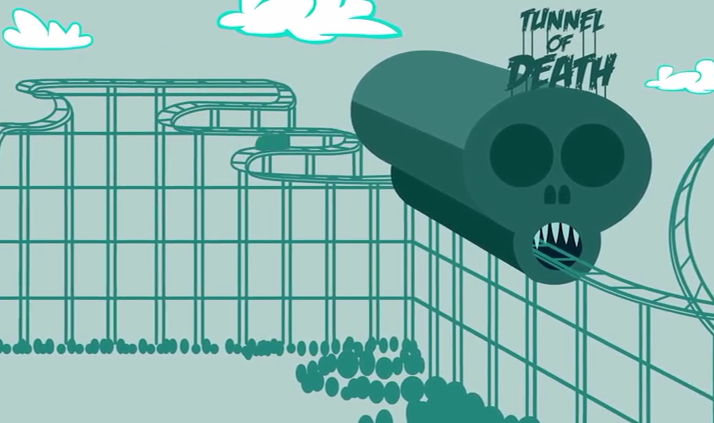Somewhere right now, people are lining up to scare themselves, maybe with a thrill ride or horror movie.
此時此刻,世界上的某個地方,人們正排著隊的體驗恐懼或許是刺激的游樂設施,或許是恐怖電影。
In fact, in October of 2015 alone, about 28 million people visited a haunted house in the U.S.
事實上,僅僅2015年10月這一個月期間,美國就有近2800萬人次選擇到鬼屋尋求刺激。
But many consider this behavior perplexing, asking the question, "What could possibly be fun about being scared?"
很多人認為這種尋求刺激驚嚇的行為令人費解,他們提出了這樣的問題:“感受恐懼,尋求刺激有那么好玩么?”
Fear has a bad rap, but it's not all bad.
誠然,“恐懼”這個詞名聲不佳,但也并非全無是處。

For starters, fear can actually feel pretty good.
對于新人而言,恐懼確實是個有趣的東西。
When a threat triggers our fight or flight response, our bodies prepare for danger by releasing chemicals that change how our brains and bodies function.
當刺激活動引發了我們類似搏斗或飛行的反應時,我們的身體就會釋放激素,改變大腦和身體的機能,以此來應對即將到來的危險或者說“恐懼"。
This automatic response jumpstarts systems that can aid in survival.
這套自發的快速反應系統能夠幫助我們更好的生存。
They do this by making sure we have enough energy and are protected from feeling pain,
它通過關閉某些不必要的系統,如批判性思維等來確保我們有充足的能量,
while shutting down nonessential systems, like critical thought.
從而保護我們,減輕或免除我們的疼痛。
Feeling pain-free and energized, while not getting caught up in worrisome thoughts that normally occupy our brains, that all sounds great,
想想吧,當我們充分感受著恐懼或痛苦,大腦中卻未充斥著真正身處致命危機時的憂患思緒,這是多么爽的感受啊。
and it can be because this response is similar, though not exactly the same to what we experience in positive, high-arousal states,
而這是可行的,因為恐懼刺激產生的情緒和感受同那些常見的正向高喚醒情緒的反應大同小異,
like excitement, happiness, and even during sex.
比如激動、高興甚至性行為。
The difference lays in the context.
他們的區別就在于處境不同。
If we're in real danger, we're focused on survival, not fun.
當真正身處險境時,我們更多關注的是如何生存而非享受恐懼。
But when we trigger this high arousal response in a safe place, we can switch over to enjoying the natural high of being scared.
但是當我們在安全的環境中嘗試這種高喚醒情緒時就能夠全身心的去感受這種恐懼帶來的純天然“高潮”。
It's why people on roller coasters can go from screaming to laughing within moments.
這就是為什么人們在乘坐過山車時能夠在瞬息間完成尖叫和大笑的轉變。
Your body is already in a euphoric state. You're just relabeling the experience.
我們的身體其實早已處于愉悅狀態了。我們只是在自我催眠,好像自己真的身處險境一樣。
And though the threat response is universal,
研究表明,雖然這種這種“恐懼愉悅”現象十分普遍,
research shows differences between individuals in how the chemicals associated with the threat response work.
卻仍會因個體的不同體現出些許差異。這種區別體現在激素刺激產生愉悅感的過程中。
This explains why some are more prone to thrill-seeking than others.
這就解釋了為什么有些人更熱衷于去尋求刺激,感受恐懼。


